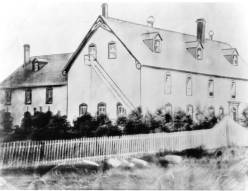
The CanadianIndian residential school system was a network of boarding schools for Indigenous peoples. The network was funded by the Canadian government's Department of Indian Affairs and administered by Christian churches. The school system was created to isolate Indigenous children from the influence of their own culture and religion in order to assimilate them into the dominant Canadian culture. Over the course of the system's more than hundred-year existence, around 150,000 children were placed in residential schools nationally. By the 1930s, about 30 percent of Indigenous children were attending residential schools. The number of school-related deaths remains unknown due to incomplete records. Estimates range from 3,200 to over 30,000, mostly from disease.
The Royal Commission on Aboriginal Peoples (RCAP) was a Canadian royal commission established in 1991 with the aim of investigating the relationship between Indigenous peoples in Canada, the Government of Canada, and Canadian society as a whole. It was launched in response to status and rights issues brought to light following events such as the Oka Crisis and the failure of the Meech Lake Accord. The commission culminated in a final report of 4,000 pages, published in 1996 and set out a 20-year agenda for implementing recommended changes.

Nicholas Flood Davin, KC was a lawyer, journalist and politician, born at Kilfinane, Ireland. The first MP for Assiniboia West (1887–1900), Davin was known as the voice of the North-West.
Noel Victor Starblanket was a Canadian politician. For two terms from 1976 to 1980 he was chief of the National Indian Brotherhood.

Calvin Murray Sinclair, (born Mizanay Gheezhik; January 24, 1951, is a former member of the Canadian Senate and First Nations lawyer who served as chairman of the Indian Residential Schools Truth and Reconciliation Commission from 2009 to 2015. He previously served as a judge in Manitoba from 1988 to 2009, being the first Indigenous judge appointed in the province. Sinclair was appointed to the Senate of Canada on April 2, 2016. In November 2020, he announced his retirement from the Senate effective January 31, 2021.

Alexander Wuttunee Decoteau, was a Cree Canadian track and field athlete, police officer and soldier. A member of the Red Pheasant First Nation, he joined the Edmonton Police in 1911 becoming the first Indigenous police officer in Canada. Decoteau was known for his athletic ability and his achievements in running. A holder of numerous long-distance records in Western Canada, he represented Canada in the 5,000 meters event at the 1912 Summer Olympics. Decoteau joined the Canadian Expeditionary Force in April 1915 and died on October 30, 1917, during the Second Battle of Passchendaele.

The Truth and Reconciliation Commission of Canada was a truth and reconciliation commission active in Canada from 2008 to 2015, organized by the parties of the Indian Residential Schools Settlement Agreement.

Peter Henderson Bryce was a public health physician for the Ontario provincial and Canadian federal governments. As a public official he submitted reports that highlighted the mistreatment of Indigenous students in the Canadian Indian residential school system and advocated for the improvement of environmental conditions at the schools. He also worked on the health of immigrant populations in Canada.

Cowessess First Nation is a Saulteaux First Nations band government in southern Saskatchewan, Canada. The band's main reserve is Cowessess 73, one of several adjoining Indigenous communities in the Qu'Appelle Valley. The band also administers Cowessess 73A, near Esterhazy, and Treaty Four Reserve Grounds 77, which is shared with 32 other bands.
The Sixties Scoop, also known as The Scoop, was a period in which a series of policies were enacted in Canada that enabled child welfare authorities to take, or "scoop up," Indigenous children from their families and communities for placement in foster homes, from which they would be adopted by white families. Despite its name referencing the 1960s, the Sixties Scoop began in the mid-to-late 1950s and persisted into the 1980s.

Qu'Appelle Indian Residential School (Q.I.R.S.) or Qu'Appelle Industrial School was a Canadian residential school in the Qu'Appelle Valley, Saskatchewan. As one of the early residential schools in western Canada, it was operated from 1884 to 1969 by the Roman Catholic Church for First Nations children and was run by the Missionary Oblates of Mary Immaculate and the Grey Nuns. As of November 8, 2021 Star Blanket Cree Nation started searching for unmarked graves using ground-penetrating radar.

The National Day for Truth and Reconciliation, originally and still colloquially known as Orange Shirt Day, is a Canadian holiday to recognize the legacy of the Canadian Indian residential school system.
Arthur "Art" Obey was a Canadian ice hockey coach with the Lebret Indians. While Obey coach them Lebret Indians, they dominated amateur hockey for five years. He was a participant in multiple sports and twice received the Tom Longboat Award. He went on to work in sports and recreation at various locations in Saskatchewan, including initiating the Indian Summer Games in that province. He is considered a "builder and leader in recreation and sport development for Aboriginal people."
Herbert Strongeagle is considered "a role model for 'breaking the stereotype, myths and perception of Native people that is constantly reinforced by hockey people and the media" by his community, and in 2006 received the First Nations Lifetime Achievement Award - Saskatchewan. Early in his life he was awarded the Tom Longboat Medal as Best Indian Athlete in Saskatchewan for his contributions to his junior baseball and midget and juvenile hockey teams, along with track and field and basketball, and continued to receive awards from his community for contributions through his lifetime.
George Lawrence Poitras, Paskwaw-Mostos-Kapimotet was a teacher and later Chief of the Peepeekisis Cree Nation.

The National Centre for Truth and Reconciliation is the archival repository for all of the material collected by the Truth and Reconciliation Commission of Canada, purposed to compile the complete history and legacy of Canada's residential school system.
Gordon's Indian Residential School was a boarding school for George Gordon First Nation students in Punnichy, Saskatchewan, and was the last federally-funded residential school in Canada. It was located adjacent to the George Gordon Reserve.

The Marieval Indian Residential School was part of the Canadian Indian residential school system. Located on the Cowessess 73 reserve in Marieval, Saskatchewan, it operated from 1898 to 1997. It was located in Qu'Appelle Valley, east of Crooked Lake and 24 km (15 mi) north of Broadview.
The Canadian Indian residential school gravesites are burial areas for an unknown number of students that died while attending the Canadian Indian residential school system. Comparatively few cemeteries associated with residential schools are explicitly referenced in surviving documents; however, the age and duration of the schools suggests that most had a cemetery associated with them. Most cemeteries were unregistered, and as such the locations of many burial sites of residential school children have been lost. The Truth and Reconciliation Commission of Canada has called for "the ongoing identification, documentation, maintenance, commemoration, and protection of residential school cemeteries or other sites at which residential school children were buried."
The Muscowequan Indian Residential School was a school within the Canadian Indian residential school system that operated on the lands of the Muskowekwan First Nation and in Lestock, Saskatchewan, from 1889 to 1997.
















